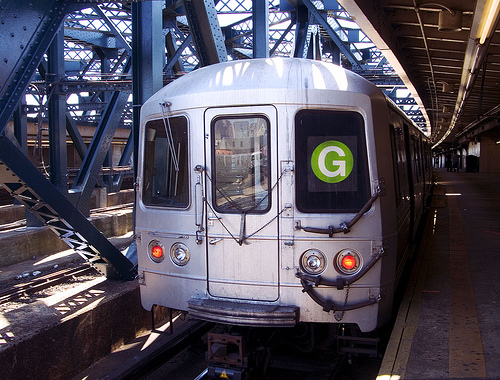
Does the Citi Bike system have a fundamental role in providing resiliency to the city’s overstretched transportation network?
The beloved or scorned G line (which provides much-needed service between Brooklyn and Queens) was heavily damaged during Hurricane Sandy, particularly affecting the tunnel beneath Newtown Creek. Now the MTA is in conversation with the Bloomberg administration about funding an expansion of Citi Bike stations to areas without G train service in Long Island City and Greenpoint; in which case, the trains won’t be running, but more bikes will.
Long Island City and Greenpoint were both meant to have Citi Bike stations prior to Sandy, but the docks for those areas were damaged while housed in a flooded area of the Brooklyn Navy Yard. Now that the G train is beginning it’s own post-Sandy flooding repairs, newly-installed Citi Bike stations could take some of the transportation demand, it is hoped.
July 6th marked the beginning of the planned weekend service suspension between the Court Square and Greenpoint Avenue stations. The G line tunnel will be closed for twelve consecutive weekends through mid-December for repairs. In the summer of 2014, officials say that the three northernmost stops on the G line – Greenpoint Ave, 21st Street and Court Square – will be closed for five consecutive weeks.
Some are skeptical Citi Bike stations can really accommodate the many commuters now without G train service. One commenter on the Daily News lamented: “How about just running some more buses? You already have the buses, and you already have the drivers? Why is that not an option?” Though shuttle buses now run along the G line route, many commuters report long lines and waits, especially during rush hour.
Citi Bike is also an imperfect substitute for mass transit: not helpful if you can’t ride a bike, are elderly, disabled, traveling with a young child, or carrying bulky packages, and marginal if the weather is bad.
And the roadways along the G line may be tricky; one commenter pointed out on Transportation Nation, the Pulaski Bridge bike and pedestrian lane is already heavily trafficked, with little room to accommodate riders and walkers as it is. For increased ridership, a solution might mean turning one of the six traffic lanes on the bridge into a bike-only path. This step may require a good deal of pushing by community organizers, and the Brooklyn and Queens committees of Transportation Alternatives are working on it.
But what’s encouraging is seeing how flexible the city becomes as more options for commuting appear. Since Hurricane Irene in 2012, when the subway system was shut down as a precautionary measure for the first time, it’s become apparent that resiliency is a key feature going forward. Ten thousand zero-carbon surface vehicles are not a bad start.
Photo Credit: Blogspot